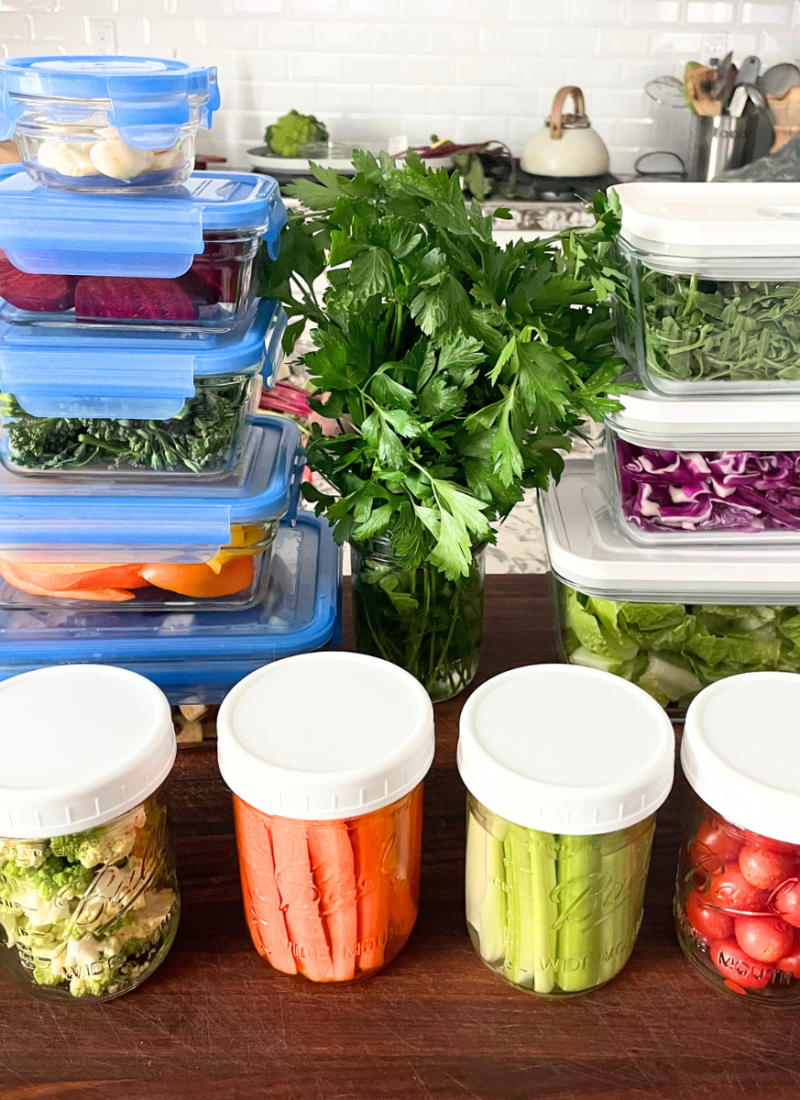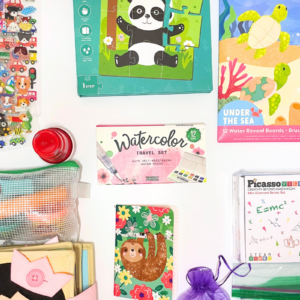Meal Planning System guide: Learn to streamline weekly meal prep, reduce effort, and save time with effective strategies
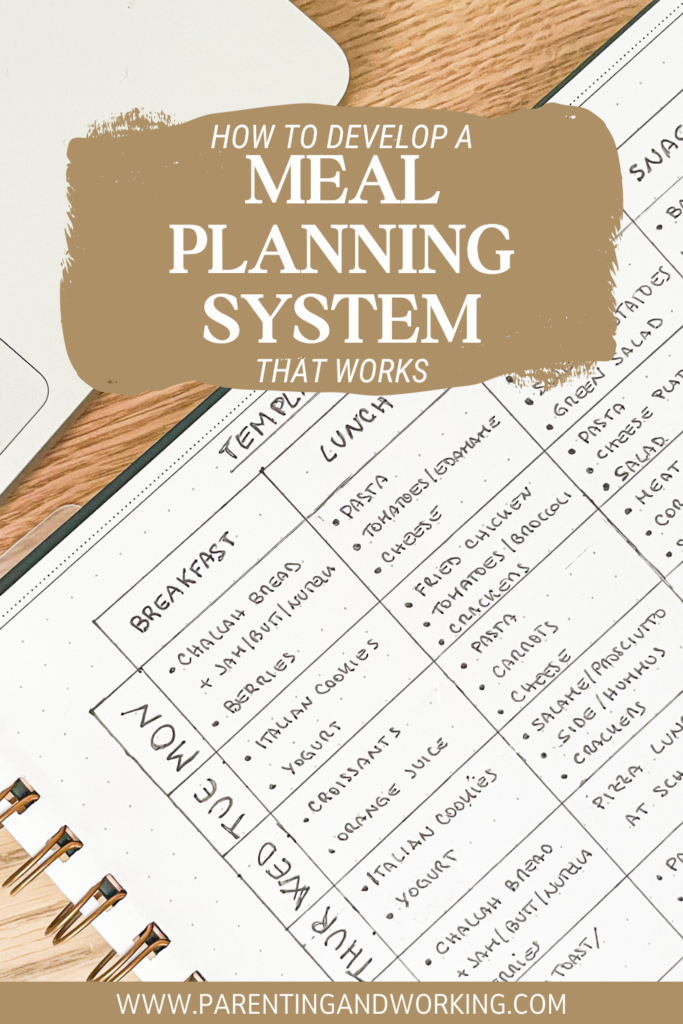
If you want to take your traditional meal planning to the next level, consider implementing a Meal Planning System. A Meal Planning System is based on the idea of creating a Master Meals List & a Template Menu. This includes your family’s favorite meals divided into groups such as “Fish Meals”, “Pasta Meals”, “Sides”. A Template Menu shows which of those general food groups you are going to have each day of the week. For example, “Fish” on Monday, “Pasta” on Tuesday, etc, but without specifying which kind of fish or pasta meal you are having. When it comes time for your weekly meal plan, you will use your template menu and master meals list to decide which specific fish and pasta meals you are going to have.
For instance, you may opt for fish sticks as “Fish” on Monday and pesto pasta as “Pasta” on Tuesday. A meal planning system will help you reduce the mental labor and the time needed for your weekly meal planning. If you are interested to know more, keep on reading and don’t forget to give a look at the printable Meal Plan Template.
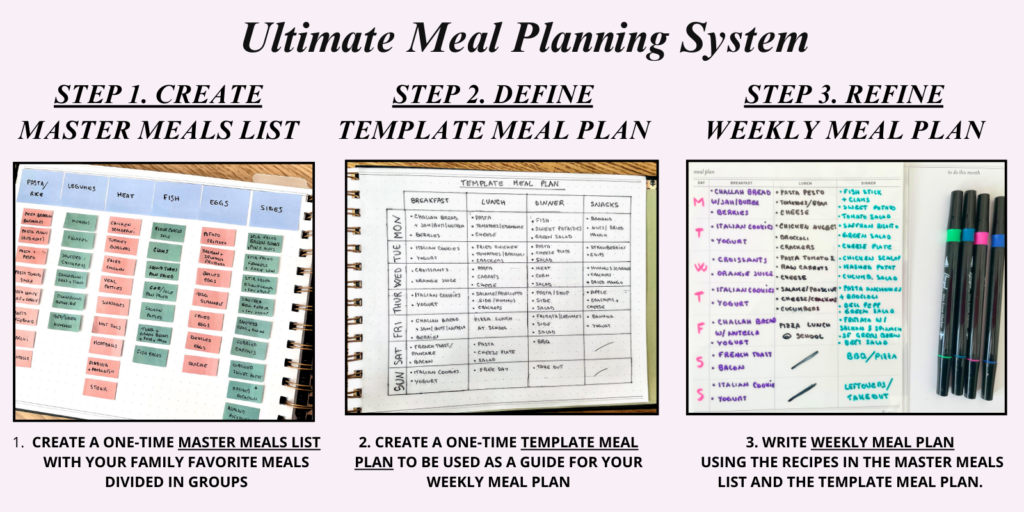
What is Traditional Meal Planning and Why Is It Important?
Traditional meal planning refers to the creation of a weekly menu. In this menu, you specify what you plan to prepare for your weekly meals. There are different ways to implement meal planning, each one with a different level of complexity. For instance, you can meal plan lunch and dinner. Or you can plan only dinners. Or just the main courses and not the side dishes. Regardless of the type of meal plan implemented, meal planning is a great way to reduce the decision-making around food. This makes it very beneficial to busy people. Specific advantages include:
- Reducing stress as it removes or reduces decision-making around food
- Saving money and reducing food waste as you will buy only the ingredients needed to cook your planned menu
- Eating better will force you to think about what you want to eat
How do you implement Traditional Meal Planning?
To implement traditional meal planning you simply need to:
- Decide which meals of the week you want to plan (ex: only dinners Mon to Fri)
- Write a list of the meals you want to eat for each day of the week.
At the end of the meal planning process, you should have created two things: menu for the week and a grocery shopping list. The downside of traditional meal planning is that you need to come up with a new weekly menu every week. This takes a lot of time, is stressful, and busy moms can burn out quickly. A better alternative is to create 4-5 weeks worth of meal plans and keep repeating them for several months. But if you always like to have a different menu each week but don’t want the stress of regular meal planning, then you should consider a Meal Planning System.
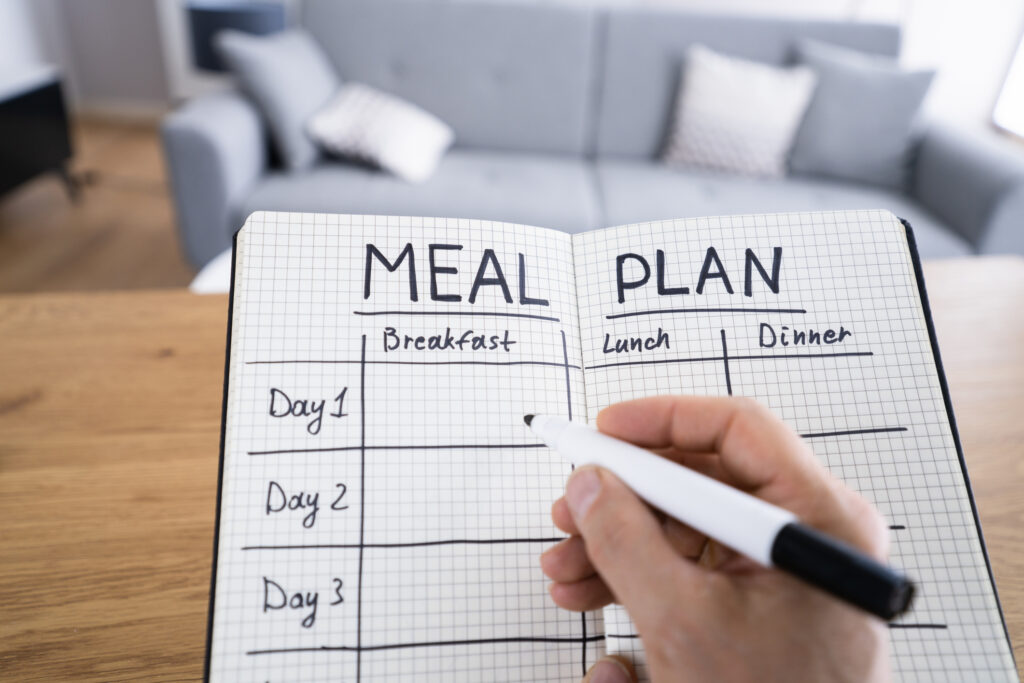
What is a Meal Planning System and How is it Better than Traditional Meal Planning?
A Meal Planning System is based on the idea of creating a Master Meals List. This includes your family’s favorite meals and a Template menu. Here you assign to each day of the week one or more general meal groups. For example, “Meat” and “Sides” on Monday, “Pasta” and “Salads” on Tuesday, etc. When the time comes for meal planning, you start populating your template menu with the meal ideas in the master meals list. For instance, if on Wednesday you have “Pasta” you can choose from your meals list pasta with tomato sauce, pasta with pesto, or any other in your “pasta” group. You keep doing this for each day of the week until you have created your menu for the week.
This method is best because it achieves the same goal as traditional meal planning, which is to reduce the decision-making around food. But it does it with much less stress as you will always use your template menu and master meal lists to guide. This method also maximizes the flexibility of meal planning. You can choose your recipes based on your needs for the week. For instance, if you want to use some specific ingredients, you can use a recipe in your master recipe list that needs those exact ingredients. Combining meal planning with some food-prepping techniques such as meal prep or ingredient prep is a great way to prepare weekly meals much more seamlessly.
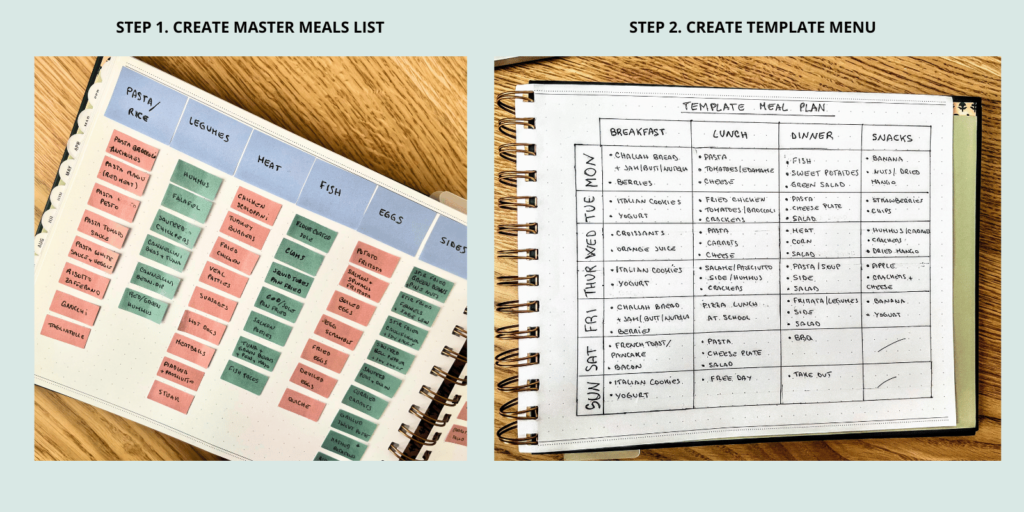
How to Implement a Meal Planning System?
To implement a meal planning system, the first thing to do is to create a template menu and a master meals list. This can take a few hours. It requires some deep thinking about the food your family loves and that you want them to have during the week. The good news is that once these two steps are done, you don’t have to change for a long time. Until you feel the need to update them.
Step 1 – Master Recipe List
Create a master list of recipes that the family loves and split them into categories. This can be done in many ways. For instance, you can split your categories as Breakfast, Lunch, Dinners, and Sides. Or you can split them as Meat, Fish, Sides, Pasta or a combination of the two. You can choose how to better split your categories. But keep in mind that some of those categories are what you will use in your meal plan template. If you are an overachiever, each recipe you write in the master list should include a list of ingredients needed.
Step 2 – Template Menu
Create a template menu divided by the categories chosen in Step 1. For instance, you may want your template menu to have fish for dinner on Monday, Pasta on Tuesday, Meat on Wednesday, Eggs on Thursday, etc. In the example below, I made a template menu using most of the categories from the master recipe list such as “fish”, “meat”, “eggs”. But sometimes I clearly wrote sweet potatoes rather than side, because I like to couple the sweet potatoes with the fish most of the time (kids don’t like fish but love sweet potatoes, so it is a compromise).
The idea of a template menu is to ensure you have the proper intake of all the food groups that your diet allows while maintaining the flexibility to change which recipe to make each week. For instance, if you eat meat on Wednesday, that could be roasted chicken one week, a steak another week, or hamburgers another week. Once you have taken some time to complete Step 1 and Step 2, you should now have a Master Recipe List and a Template Menu ready to use every week that you want to meal plan. See one great meal plan idea in the pictures below.
After these two steps have been completed, you need to complete the following every week:
- Create the weekly meal plan by choosing recipes from the master recipe list to follow your template menu.
- Come up with a grocery list.
- Implementation of the meal plan, go to the grocery store, or do online shopping.
- Do ingredient prep or meal prep for a week’s worth of meals, if you have extra time (optional).
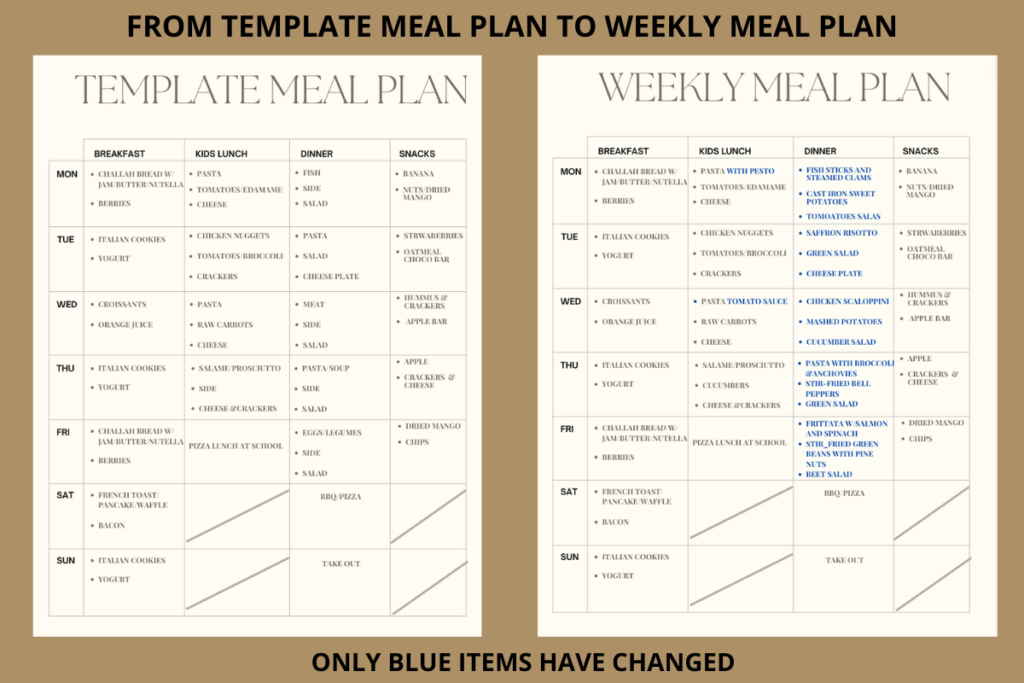
How to Create a Master Meals List?
There are many ways to create a master recipe list but the general idea is to group your favorite recipes in categories that will then be used to create the meal plan template. In the example below, recipes were divided into 12 groups but you can do something different and even start with 5 categories. One other trick is to write the ingredient list needed for each meal, so it will make it easier to create a grocery list just by adding the ones you don’t already have to your grocery list. See some simple meal ideas in the picture below. Don’t forget to include your children’s favorite recipes.
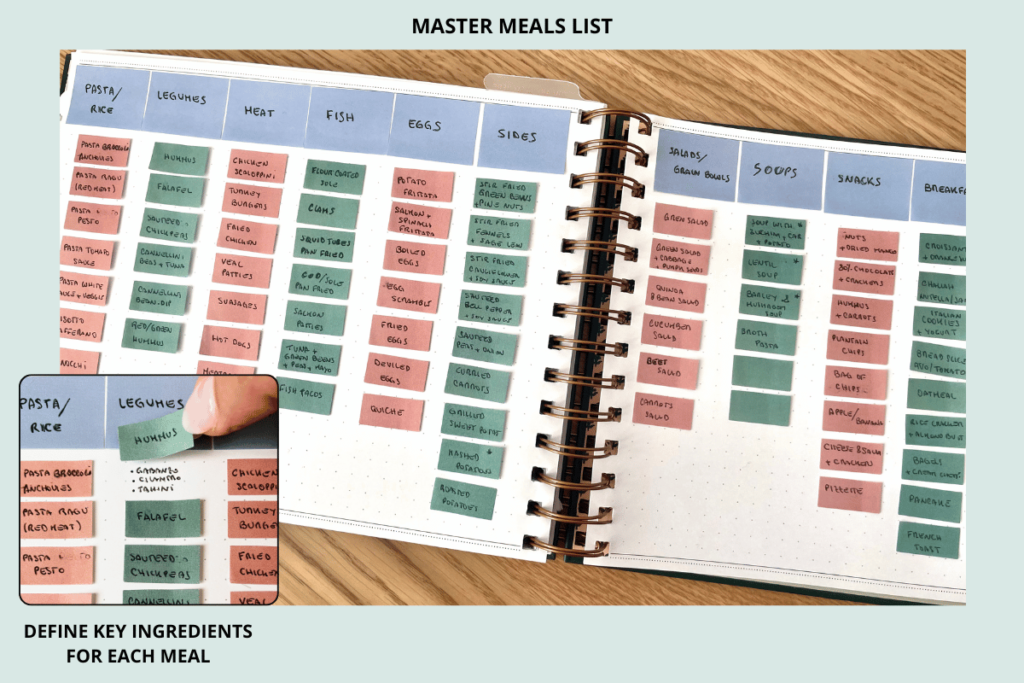
How to Create a Template Menu?
Start by dividing each day into the meals you want to plan, that could be all three meals (breakfast, lunch, dinner), or maybe just one meal (dinner). Next, you want to decide which meals you want to plan differently every week and which ones have a fixed menu. For instance, the template meal plan below has a fixed menu for “Breakfast” and “Snacks” as those meals are the same ones every week, so there is no need to meal plan them every week.
The next step is to start populating your template menu with some of the categories listed in the master recipe list, such as “White Meat” for Monday night, “Taco” for Tuesday night, and “oatmeal” for breakfast on Monday and Wednesday. You want to put in that plan your best effort in creating a healthy diet, which does not only mean choosing healthy meals but also making sure lunches and dinners are balanced so you get all the needed nutrients every day. For example, if you have had proteins for lunch, you may want to consider having carbs for dinner. Similarly, you want to make sure that in an entire week, you have enough variety and nutrients, this will change depending on your family’s needs and preferences.
For instance, the meal plan below has a good combination of meat, fish, legumes, and eggs for healthy eating. It also includes a raw and cooked veggie for every meal.
Additional important components of effective meal planning
- Include a day for leftovers
- Plan the quickest meals for the days when you won’t have much time to cook
- Plan earlier in the week meals that include fresh food that spoil early like fresh fish or berries
- Consider grocery budget and ingredients you already have at home.
Once you are done filling out the template meal plan, give it another look. Make sure you have included all the food groups that you want you and your family to have every week. One of the best advice when it comes to planning meals for kids is to always include something that they love as part of any meal. For instance, if you want them to eat something that they don’t love (like fish) make sure you serve it next to one of their favorite side dish.
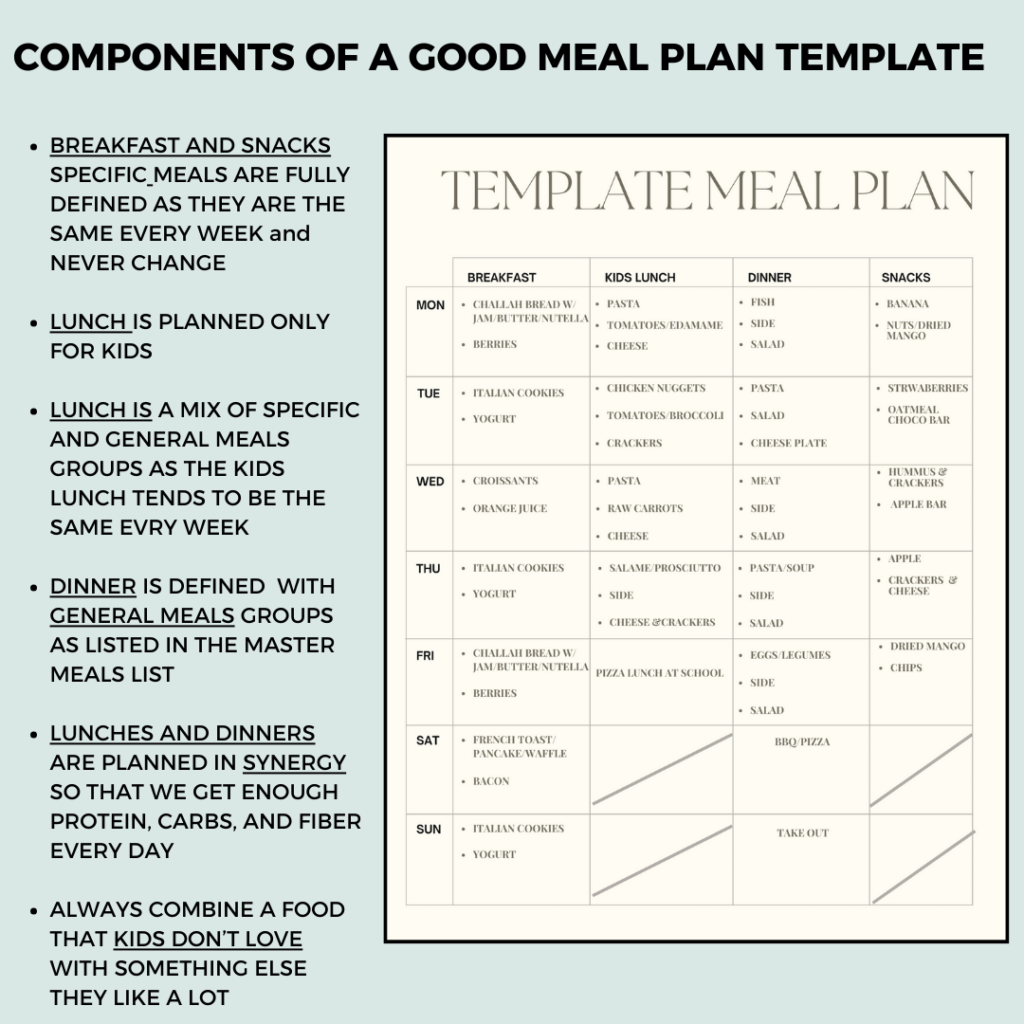
Favorite Tools for Meal Planning?
The are tons of traditional meal planners available for free in digital format which you can use. One great option is the free printable Meal Plan template that I created for you! If you want to invest in some planning tools, interesting options are these mini-stickers by Laurel Denise which were used to create the master recipe list. Also interesting, is the pop-in panel for the weekly meal plan to be used with the Laurel Denise planner. This meal planning panel is interesting because you write in it with wet-erase markers so you can keep the fixed components of the meal plan every week, and plan for just the meals you change weekly. For a more simple but elegant paper-based meal planner, consider this one by Ramona and Ruth.

